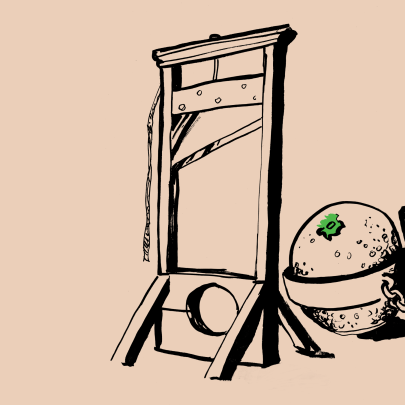Jun 24, 2013 Politics
Believe it or not, Aucklanders are arguing about architecture. I’m delighted. It’s an argument this city needs to have. Why is it, when we live with such natural beauty, that our city has some of the ugliest and most boring architecture on the planet? I blame any media which treats architecture as a dirty word and architects as intellectual snobs and servants of the rich who will prostitute their design ideals for a quick buck.
While there’s some truth to this view of the servile profession, architects are also trained to play a vital social role, as the creators of beautiful buildings and intelligent urban design. So why do we have theatre and movie critics, and book, music, TV and food critics, but no regular equivalent in mainstream media to critique architecture and our built environment? Maybe we need Prince Charles.
In 1984, Charles launched a stinging attack on modern architecture when he told the Royal Institute of British Architects that a proposed extension to the National Gallery in Trafalgar Square was a “monstrous carbuncle on the face of a much-loved, elegant friend”. Shortly after that, several newspapers began regular coverage of architecture with dedicated correspondents.
In Auckland, unless we are regularly talking about our built environment, something so fundamental to how we live, we will not get very far. Tragically, new building is mostly discussed in our newspapers as merely real estate, with no critical appraisal. We don’t have celebrities of the heft of Prince Charles or Grand Designs’ Kevin McCloud to raise critical questions about good and bad design, but great architecture needs great argument.
Auckland does, however, have the Unitary Plan, which has, at least, got people bickering. The pity is that the discussion is so dim-witted, poorly informed and instantly polarised, thanks, in part, to shrill media coverage. “The proposals have not gone down well with some councillors, who fear it will lead to slums and multi-storey ‘walls’ along popular beachfronts such as Orewa and Browns Bay,” reported the New Zealand Herald on February 21.
By the end of April, the conspiracy had worsened, with the Herald reporting that some residents believe “the council is paying lip-service and acting like the government of Cyprus to steal property rights for a bankrupt agenda”. Local publications such as the North Shore Times have fuelled the hysteria with an ongoing barrage of anti-the-plan headlines. Some examples: “High-rise plans are flawed says councillor”, “Battle lines drawn” and “Consultation just ‘lip service’”.
The other culprit is the council, whose PR on this undertaking, while well intentioned, has been woeful. Consultation meetings have been poorly publicised and poorly run. These should have begun with highly polished presentations, explaining the key messages of the plan and the way forward. Instead, they have relied on town planners stumbling their way through explanations, exposing themselves as possibly the worst communicators in the universe. Mayor Len Brown’s engagement with the process has been waffly, garbled and unconvincing.
A sample from his off-the-cuff speech, at the Town Hall chamber on April 18: “… the Unitary Plan basically sets the rules and one of the key issues around the Unitary Plan for people’s consideration is if you are not going out as much as what we’ve previously done, but we will be going out and taking in 146 square kilometres of more greenfields land, so it’s a balance project — a bit out, a bit up.” Dear lord, get this man a speechwriter now.
Brown burbles on: “… that we preserve our built heritage here already; and secondly, that we do so in a way that doesn’t insult the eye of the observer and the inhabitant when you are going up and you’re building and developing things from apartment blocks and court houses and terraced houses.”
Court houses? No doubt the mayor has his heart in the right place. But where was the advertising campaign to lay out the issues? Sadly, Brown has been a leader missing in action, when he should have been the visionary in the vanguard.
Online, the message also became hopelessly bogged down. If you know what you’re doing, it takes at least five counter-intuitive clicks to get near information about your property’s zoning rules via the Unitary Plan. Having online access to all the maps and data is laudable as an idea, but clearly it’s a work-in-progress.
The real crisis here is the lack of knowledge, or rather the transfer of knowledge from those in the know to those in the dark. Hence this typical interchange — in this case, about Grey Lynn — at one of the Unitary Plan events.
A Peel St resident: “The last thing we need in terms of character, amenities, quality of life — we have been there for years — is to have four-storey apartment buildings. Why? What is the purpose? We have a right to be angry.”
Planner: “So you are saying we have got it completely wrong. [Laughter.] That’s genuinely what we want to know.”
A Schofield St resident is also upset, on account of a proposed rezoning to mixed housing. “Frankly, this threatens to get rid of a very lovely collection of bungalows and villas and a nice neighbourhood which I particularly enjoy living in. Council may not see it as heritage, but the people who live there definitely do.”
The planner points out that nothing will necessarily be destroyed by the zoning, especially if no one sells their properties, and that all houses built before 1944 require resource consent to be demolished. That would invoke a “character assessment” of her property and surrounds which would likely result in the street getting heritage protection.
Someone else asks why isn’t demolition of pre-1944 building something that is automatically publicly notified. “Thanks for that feedback,” says the planner politely. “We’ve had quite a lot of similar suggestions at other meetings. Please make sure you formally send us that proposal.”
Despite repeated assurances this is a draft plan and all feedback will be considered with a view to making changes, it’s obvious many people don’t believe the consultation is genuine. Many appear to have no idea they are in a consultative process. Mistrust pervades — us against them in an antagonistic, adversarial foray. A crisis of confidence.
Yet on the face of it, the Unitary Plan is the largest community consultation project Auckland has ever seen. A plan to design this city by the people for the people. What’s not to like? Perversely, the democratic process under way seems to be producing the opposite effect — a suspicion that the council is conspiring against the people.
The “Save our Cities” group certainly think so. “We have no confidence in the council at all,” says one resident at a packed meeting in Belmont on May 5. “If we are a more affluent suburb, that is just the way it is. You have to work a bit harder to live here… We want our environment to be nice. I want it to be better than some other parts of Auckland.”
Grant Gillon, Kaipatiki Local Board member and one of the meeting’s organisers, whips up the outrage with a visualisation of what four-storey “monolithic” structures look like. One resident says the image reminds him of “postwar East Germany”, likening it to “the most unsightly looking apartments you could imagine” already on Taharoto Rd. He’s convinced the same “halfwits” who allowed those “are going to allow the same things to happen all over Belmont, Bayswater and Takapuna”.
A local architect takes the microphone to point out density doesn’t have to look awful. “It’s unfair to say if it’s four storeys high, it looks like this,” says the architect. “The pictures of density would not be reinforced by people who live in Portland, Oregon, or Amsterdam or London or almost any European city.”
Gillon disputes the one million people growth figure. He thinks it will be more like 300,000. An Aramoana Ave resident of 40 years points out intensification has already happened with infill housing all around him, subdivisions and apartments across the road. “It’s increased in my day, so what do you expect is going to happen in the next 30 years?” he asks. “Rather than just rubbishing this system, we must put up proper solutions.”
Another agrees: “It’s all very well to say put it somewhere else, which is a typical nimby attitude. Where in the greater Auckland area is the perfect place for an extra 300,000?”
Among the largely older crowd, a younger voice raises the spectre of a geographical divide, and how the plan may address an emerging destructive generation gap. “The young people I know want to stay living here. We don’t want to move to Te Hana or Huntly to get a house. We’d like to stay living in our communities on the Shore because we love it. At the moment, there isn’t a lot of housing for people younger than me to live here in the future.”
No one listens. The meeting passes a resolution that “utterly rejects the proposed Unitary Plan”.
Do nothing. Not in my backyard. Yet still the people keep coming to “the world’s most liveable city”. Where do they go? One popular solution is sleepout cabins, which are popping up all over the city in the backyards of overcrowded households needing an extra bedroom.
“When times get tough a lot of people cope by moving in with each other,” RoomMate cabin rental owner Andrew King told the Sunday Star-Times. The cabins run off mains power and are under 10sqm, which means as long as they don’t have plumbing, they don’t require a building permit in many parts of Auckland.
The Unitary Plan offers a more permanent solution, allowing single houses to be altered to include a rental unit. It’s known as “gentle intensification”.
Gillon claims a key problem of the Unitary Plan is the lack of consultation — particularly in the Belmont area, where he says there has been none. Odd, because the day before, in the torrential rain, I attend, with other hardy souls, a Belmont Unitary Plan Walk led by Devonport-Takapuna Local Board members Chris Darby and Dianne Hale.
“There is development here in the existing plans that has not been realised. The market has not taken it up,” says Darby. It’s a good point. Zoning is no silver bullet for the real problem facing Auckland: not enough building.
Darby has no doubts about the population growth and he also acknowledges the baby-boomer problem — 50 per cent of the dwellings in Devonport are one- and two-person households. That’s led to a housing shortage for both the young and those in the later stages of life. The elderly “haven’t stayed in Devonport. They have had to move north to retirement villages.”
He asks those present to look across to the Belmont local centre — a rather tawdry collection of fast-food outlets, a liquor store and rundown shops split by the traffic nightmare of Lake Rd.
Darby: “How do you see it in 20 or 30 years? Can you see some retail at ground level and maybe some people working at the next level? And is there a third level with some apartments? Is that it, or is there a fourth level in your mind?”
Resident: “What about the Lake Rd gridlock?”
Darby: “Let’s say we’ve got good infrastructure to get people in and out of here — a tram system or a contemporary light-rail system. What do you see?”
Resident: “I’d like to see a village space, well designed in terms of people being able to walk around — safe for kids, accessible for elderly and providing some of the facilities instead of having to go to the supermarket. A place where people can meet and greet and also do some of their basic shopping. A little hardware store, that’s the sort of thing. Not just all cafes and takeaway places or rundown dairies. We want a village atmosphere.”
Planner: “Do you think there would be a little town square?”
Resident: “Yes.”
For a moment, peace has broken out. Darby and Hale provide a great example of what needs to be happening all across Auckland. This is our chance to argue the Auckland we want into existence. As the bedraggled prepare to leave, with promises to meet again in a week’s time, an elderly resident signs off. “Can I just say thank you to the three of you. It’s nice to get advice and it’s also nice to be listened to.”
Chris Barton is Metro’s urban design columnist.
More on the Auckland Unitary Plan: Anger and Hope: The Battle to Build the City We Deserve, by Simon Wilson.





